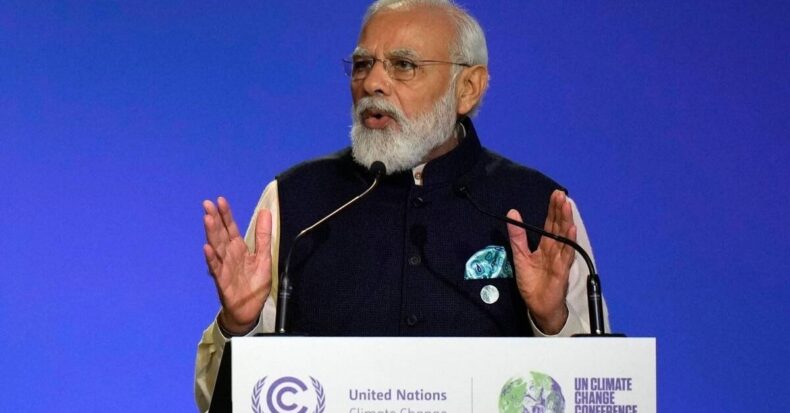PM Modi made Panchamrit Promises at the Climate Change Summit in Rome. A look at the current technologies in India for tackling Climate Change.
Prime Minister Narendra Modi’s two days trip to Rome for the G20 Leaders’ Summit ended ‘Fruitfully’ as per his tweet.
At the United Nations Climate Change Conference in Glasgow, Prime Minister Narendra Modi presented India’s agendas to tackle climate change.
On Monday 1st November Narendra Modi delivered the National statement at Glasgow’s Climate Change Conference calling the ‘Panch Amrit Tattava’ (five nectar elements) while delivering the five-point India’s agenda in tackling Climate Change.
PM Modi’s Panchamrit on Climate Change
- India will reach its non-fossil fuel energy capacity to 500 GW by 2030.
- India will meet 50% of its energy requirements from renewable energy by 2030.
- By 2030, India will reduce the total projected carbon emissions by 1 billion Tonnes.
- India will achieve the target of net-zero emissions by 2070.
Greta Thunberg, a Swedish teen activist, tweeted, “That’s how young people around the world are describing our governments’ failure to cut carbon emissions, feeling ‘betrayed’ and disappointed about the COP-26 Conference where 120 world leaders are meeting in Glasgow. Greta is also in Glasgow with thousands of other protestors.
Leonardo DiCaprio also sent his message to the world leaders of not losing any time and taking instant action to protect the planet.
An outrage surfaced among the public against the world leaders for taking an estimated 400 private planes to the summit. The world leaders are questioned for their commitment to cut carbon emissions while using private transports that generate a lot of carbon.
Current Climate Technologies in India
- India currently sources 2% of its energy requirements through nuclear energy.
- National Offshore Wind Energy Policy2015 has developed the onshore wind power program with a 23 GW power supply installation.
- Chakr Innovation from Delhi helps capture 90% of particulate matter emissions from the diesel generator’s exhaust air without affecting its energy efficiency.
- Solar Ferryis a 75-seater ferry that gets more than 80% of its energy from solar power.
- Coimbatore’s Cellzyme Biotech makes antibiotics using an engineered enzyme without using solvents at room temperature. This process replaces the harsh industrial chemicals and conserves energy by reducing the environmental footprints.
- Biomedical Waste Management can now be done by a microwave in India that eliminates air emissions and treats infectious waste.
- Currently, India uses these technologies to treat water.
○ Capacitive Deionization.
○ Ozonation.
○ Ultraviolet Technology.
○ Reverse Osmosis.
○ TERAFIL.
○ OS- Community-scale Arsenic Filter.
○ Filtration.
○ Solar Water Purification System.
- India’s score on Technology-specific RECAI scores and ranks in 2021.
○ Solar PV- 62.7 (1)
○ Geothermal power- 23.2 (16)
○ Offshore wind power- 28.6 (29)
○ Onshore wind power- 54.2 (6)
○ Biofuels- 47.4 (10)
○ Hydroelectricity- 46.4 (3)
○ Solar CSP power plants- 09.2 (4).
With 38% of installed energy capacity in 2020, India is the 3rd most significant renewable energy producer globally.

India has taken several initiatives and policies in the past that are currently helping the country handle the climate crisis in a practical way.
- National Mission for Enhanced Energy Efficiency, National Solar Mission, National Mission On Sustainable Habitat, National Mission For Sustaining The Himalayan Ecosystem, National Water Mission National Mission For “Green India”, National Mission For Sustainable Agriculture, and National Mission On Strategic Knowledge Platform For Climate Changewere the National Action Plan On Climate Change 2008.
- Environmental Impact Assessments to regulate the industries and ensure optimal use of natural resources, Eco-Sensitive Zone, and several other Laws to protect the wildlife and nature.
- Promoting Energy Conserving energy gadgets and transports.
- Providing incentives to the corporations and public on saving energies or using green energy sources.
India recently faced a considerable coal crisis despite its richness in energy resources. On the other side of the promise of improved energy sources, India still depends on fossil fuel for electricity generation, estimated to be around 80% of total electric production. Suppose the government is serious about the country’s green energy target.
In that case, the policies and goals mentioned above are needed to be communicated well to the public and implemented correctly by the government by allocating more investment in technologies and techniques for generating cleaner, safer, and healthier energy sources like Solar power, Biomass, Wind power, Biofuel, Hydropower, and Geothermal Energy.













